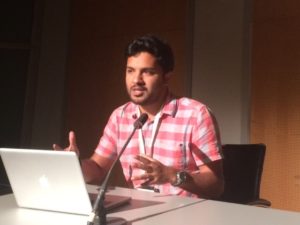
As new therapies for hepatitis C have been approved in recent years, they have been accompanied by controversies over their price, with many health systems restricting access to the new medications. Victor Roy, an MD/PhD candidate, described the tension between pharmaceutical innovation and affordability in a recently published analysis in The BMJ (formerly the British Medical Journal).
“I wanted to dig into the challenge of how the ‘innovation economy’ we often talk about now influences the health of our patients, particularly those most vulnerable. Remarkable scientific promise is also often met with questions of equity and affordability,” Roy said.
“Many vulnerable populations are disproportionately affected by hepatitis C – such as those incarcerated – and it’s important to place them at the center of our work any time we can. Financial and policy debates often make them invisible, but a human-centered approach gets us closer to meeting public health aims and also embraces the dignity of each individual patient.”
In the study, Roy outlines how large companies, expected to grow on an annual basis, acquire smaller companies with promising therapies and often take revenue from newly developed drugs and direct it to shareholders, rather than reinvesting that money into further research and development.
The article outlines future strategies to encourage more affordable prices and greater value for patients, including new business models for drug development, in addition to other solutions like giving health systems increased power to negotiate pricing and payment models.
“The piece only captures a slice of these long run shifts and their consequences for health systems and patients,” Roy said.
This research began during Roy’s graduate education in sociology at Cambridge University. Funded by a Gates Cambridge Scholarship, Roy became aware of the important pharmacological advances for patients with hepatitis C while reading through case studies.
“Doing sociology alongside clinical training is like having a high powered photographic lens,” Roy said. “You can zoom in and out to understand what shapes health at many levels from political economy to the social experience of illness.”
After he learned more about how hepatitis C drug development and the high prices caused only the sickest patients to receive this treatment when other patients could also benefit from these drugs, Roy wanted to try to understand the dynamics of drug development and the reasons for the drug’s price.
He spoke with numerous patients, physicians, industry executives and policymakers, and he reviewed hundreds of documents from financial statements to scientific articles.
“It’s like putting together a large and complex puzzle,” Roy said. “Everyone sees the challenge from their own perspective, but piecing it together can help us see where we can make improvements and be creative so that patients can benefit from biomedical advances.”
Earlier this summer, Roy also published an article in Health Affairs, proposing a model to make hepatitis C a rare disease by 2025. In the paper, Roy discussed three barriers needed to overcome to make this goal a reality: pricing and payment, delivery coordination and targeting vulnerable groups.
The model caught the attention of policymakers in New York, and Roy is working with colleagues to develop targets and strategy for eliminating the disease.
“It’s gratifying to see that research and writing can make an impact,” Roy said. “Policymakers and health system leaders are looking for clear ideas in the face of many thorny challenges, and I think our job is to be in the arena to advance solutions with precise evidence and arguments.”
Now, returning to his clinical rotations at Feinberg in the coming year, Roy plans to integrate what he has learned in his medical education and future career.
“I’m lucky that Feinberg has offered me the flexibility to bring together my interests and aspirations,” Roy said. “I see myself combining this training to tackle a range of challenges, from frontline clinical delivery to social factors such as food and housing that are powerful drivers of the health of our most vulnerable patients.”






